Damascus – al-Madrasa al-Aziziyeh دمشق – المدرسة العزيزية

While little remains of the Ayyubid-era al-Madrasa al-Aziziyeh (المدرسة العزيزية), the notable survival is the burial chamber of Salah al-Din Yousef Bin Ayoub (صلاح الدين يوسف بن أيوب). The Tomb of Salah al-Din (قبر صلاح الدين) was completed in 1196 during the brief reign of his son, al-Afdal Bin Salah al-Din (الأفضل بن صلاح الدين), over Damascus (دمشق). The surrounding religious school, of which only several columns and an interior arch still stand, was constructed shortly after the mausoleum under al-Aziz Othman Bin Salah al-Din (العزيز عثمان بن صلاح الدين).
Salah al-Din (صلاح الدين) was born to a Kurdish family in Tikrit (modern Iraq) in 1138. His father, Najm al-Din Ayoub Bin Shadhi Bin Marwan (نجم الدين أيوب بن شاﺬي بن مروان), moved the family to Mosul (Iraq) and was later appointed by Imad al-Din Zenki (عماد الدین زنكي) as commander of his fortress in Baalbek (modern Lebanon). While his father was in Baalbek, Salah al-Din (صلاح الدين) spent much of his youth in Damascus (دمشق). He obtained his education there, studying religion, history, literature and poetry, and developed great affection for the city.
Salah al-Din (صلاح الدين) began his military career in 1164 under his uncle, Assad al-Din Skirkuh Bin Shadhi (أسد الدين شيركوه بن شاذي). His uncle was an important military commander in Egypt under Nur al-Din Zenki (نور زنكي الدين), who had succeeded his father Imad al-Din Zenki (عماد الدین زنكي) by that time. When his uncle died five years later, Salah al-Din (صلاح الدين) was appointed as vizier of Egypt by the Fatimid Caliph al-Aadid (العاضد). The selection of Salah al-Din (صلاح الدين), who followed the Sunni branch of Islam, was a curious choice for the Shia Fatimid dynasty. Nur al-Din Zenki (نور زنكي الدين), who ruled from Aleppo (ﺣﻠﺐ), was hostile to his appointment. Faced with an assassination attempt and a revolt against him within six months of his appointment, Salah al-Din (صلاح الدين) soon consolidated power in Egypt that rivaled Caliph al-Aadid (العاضد) himself. He placed many family members in high-ranking positions and increased Sunni influence in Cairo. By 1170, Salah al-Din (صلاح الدين) began leading military campaigns against the Crusaders in Gaza (Palestine). al-Aadid (العاضد) died the following year, leaving Salah al-Din (صلاح الدين) with complete control over Egypt. He pledged allegiance to the Abbasid Caliph in Baghdad (Iraq), but his power over Egypt was uncontested.
While nominally allied with Nur al-Din Zenki (نور زنكي الدين), Salah al-Din (صلاح الدين) withdrew from a joint attack against Crusader castles on the outskirts of the Kingdom of Jerusalem. He suspected that Nur al-Din Zenki (نور زنكي الدين) would prevent him from returning to Egypt after the campaign, and that Nur al-Din Zenki (نور زنكي الدين) sought to annex Egypt for himself. Salah al-Din (صلاح الدين) returned, preparing for what appeared to be an inevitable military confrontation with Nur al-Din Zenki (نور زنكي الدين). He further expanded his control over Egypt and conquered Yemen in 1174. As Salah al-Din (صلاح الدين) began to assemble forces outside Cairo in anticipation of an attack from Syria, Nur al-Din Zenki (نور زنكي الدين) died from poisoning in May of 1174. He was succeeded by his eleven year old son, al-Saleh Ismail (الصالح إسماعيل). Infighting soon spread throughout the territories previously held by Nur al-Din Zenki (نور زنكي الدين), and Salah al-Din (صلاح الدين) was requested to aid in the defense of Damascus (دمشق). He soon took control of the city, appointing his brother as governor, and proceeded north to conquer the city of Hama (حماة).
The city of Aleppo (ﺣﻠﺐ) remained problematic for Salah al-Din (صلاح الدين). He besieged the city for several months in early 1175, but an assassination attempt by the Ismaili sect (also known as the Assassins) and the threat of rival forces allying against him convinced him to lift his siege and focus his attention elsewhere. He conquered the city of Homs (حمص), but soon found himself confronted by an alliance of the heirs of Nur al-Din Zenki (نور زنكي الدين) led by Seif al-Din Ghazi Bin Mawdud (سيف الدين غازي بن مودود) of Mosul (Iraq). Despite being outnumbered, the forces of Salah al-Din (صلاح الدين) emerged victorious in battle outside of Hama (حماة). With this victory, Salah al-Din (صلاح الدين) declared himself the Sultan of Egypt and Syria, and was recognized as such by the Abbasid leadership in Baghdad. In the spring of 1176, the forces of Salah al-Din (صلاح الدين) won another important battle at Tel Sultan (تل سلطان), south of Aleppo (ﺣﻠﺐ). He took several important towns in the region, including Manbej (منبج) and Aazaz (أعزاز), tightening the siege around Aleppo (ﺣﻠﺐ). By the summer, a truce requiring recognition of Salah al-Din (صلاح الدين) as the ruler of Syria was agreed upon.
Salah al-Din (صلاح الدين) still faced threats from the Ismaili sect led by Rashid al-Din Sinan (رشيد الدين سنان). Based in Syria’s coastal mountain ranges, the sect commanded nine fortresses at high elevations. Salah al-Din (صلاح الدين) failed to conquer any of these fortresses during his late summer campaign, and eventually agreed to a truce and alliance with Rashid al-Din Sinan (رشيد الدين سنان). The circumstances surrounding this agreement are disputed, with one story suggesting a threatening note was left in the tent of Salah al-Din (صلاح الدين) while he slept, despite several precautions taken to protect him from assassins. Other accounts suggest Salah al-Din (صلاح الدين) called off his siege because his forces were urgently needed elsewhere. Regardless, the agreement between Salah al-Din (صلاح الدين) and Rashid al-Din Sinan (رشيد الدين سنان) would be of major importance in future campaigns against the Crusaders.
After consolidating his power over most of Syria, Salah al-Din (صلاح الدين) returned to Egypt and worked on several infrastructure projects. In late 1177 he engaged in several raids against the Crusaders in Palestine. After initial successes, Salah al-Din (صلاح الدين) suffered a significant defeat from the forces of King Baldwin at the Battle of Montgisard (near al-Ramleh). After fleeing to safety in Egypt with a small number of remaining troops, Salah al-Din (صلاح الدين) returned to Syria. In 1178 his forces engaged the Crusaders in several skirmishes around Homs (حمص) and Hama (حماة), and in the following year around al-Quneitra (القنيطرة). In 1179, Ayyubid forces defeated the Crusaders at Jisr Banat Yaqoub (جسر بنات يعقوب) in Palestine and successfully besieged their fortress of Chastellet. Salah al-Din (صلاح الدين) continued his campaign against the Crusaders in Palestine, pressing ahead to the city of Safad before King Baldwin agreed to a truce. This truce held for the next few years.
Fighting between Ayyubid forces and the Crusaders resumed in 1182, but Salah al-Din (صلاح الدين) soon became focused on his northern frontier. Seif al-Din Ghazi (سيف الدين غازي) and al-Saleh Ismail (الصالح إسماعيل) had both passed away in 1181, and growing tension between Salah al-Din (صلاح الدين) and their successors escalated into open hostility. Ayyubid forces captured several major towns and cities in northern Mesopotamia, including al-Raqqa (الرقة) and Edessa (modern Şanlıurfa, Turkey). Negotiations resulted in Aleppo (ﺣﻠﺐ) being passed to Ayyubid control shortly thereafter. From there, Salah al-Din (صلاح الدين) incorporated Harem (حارم) into his realm and then headed towards Mosul (Iraq), placing it under siege. Despite many political and military successes in the region, and several years of effort, Salah al-Din (صلاح الدين) ultimately failed to capture the heavily fortified city of Mosul.
Meanwhile, fighting between Ayyubid forces and the Crusaders was escalating in the frontier regions. Several villages around Damascus (دمشق) were raided by the Crusaders, and Ayyubid forces responded with raids in Galilee (Palestine). Salah al-Din (صلاح الدين) besieged the Crusader castle in Karak (modern Jordan) in 1183 and 1184. Raynald of Châtillon, in response, raided pilgrimage caravans to Mecca and Medina (modern Saudi Arabia) the following year. Fighting culminated in the Battle of Hattin (Palestine) in 1187, resulting in a devastating defeat for the Crusaders. Raynald de Châtillon was captured and executed. A few months later, Jerusalem fell after a brief siege. These defeats humiliated European leaders and prompted the Third Crusade. Led by King Richard I of England, Crusader forces defeated the army of Salah al-Din (صلاح الدين) at the Battle of Arsuf (Palestine) in 1191, securing the coastal region from Tyre (Lebanon) to Jaffa (Palestine) for the Crusaders. King Richard was unable to secure a force large enough to retake Jerusalem, however. In 1192, the two sides agreed to a treaty whereby Jerusalem would remain in Ayyubid hands but would be open to Christian pilgrimages.
Salah al-Din (صلاح الدين) died of a fever in March of 1193. He was temporarily buried in the Damascus Citadel (قلعة دمشق) while his mausoleum was being constructed. The Tomb of Salah al-Din (قبر صلاح الدين) is fairly modest, a square chamber featuring ablaq walls with four arches supporting the dome. There are two sarcophagi. The original wooden tomb, richly decorated with geometric and floral patterns, is on the right side of the chamber as you enter from the east. The marble cenotaph, on the left, was added in 1878 by the Ottoman Sultan Abd al-Hamid II (عبد الحميد ثانی). The interior faience panels date to the 17th century. The mausoleum was rebuilt in 1898 under the patronage of the German Emperor William II, who financed the repairs after he visited Damascus (دمشق) and found the tomb in a state of disrepair. The tomb is open to the public throughout the day.
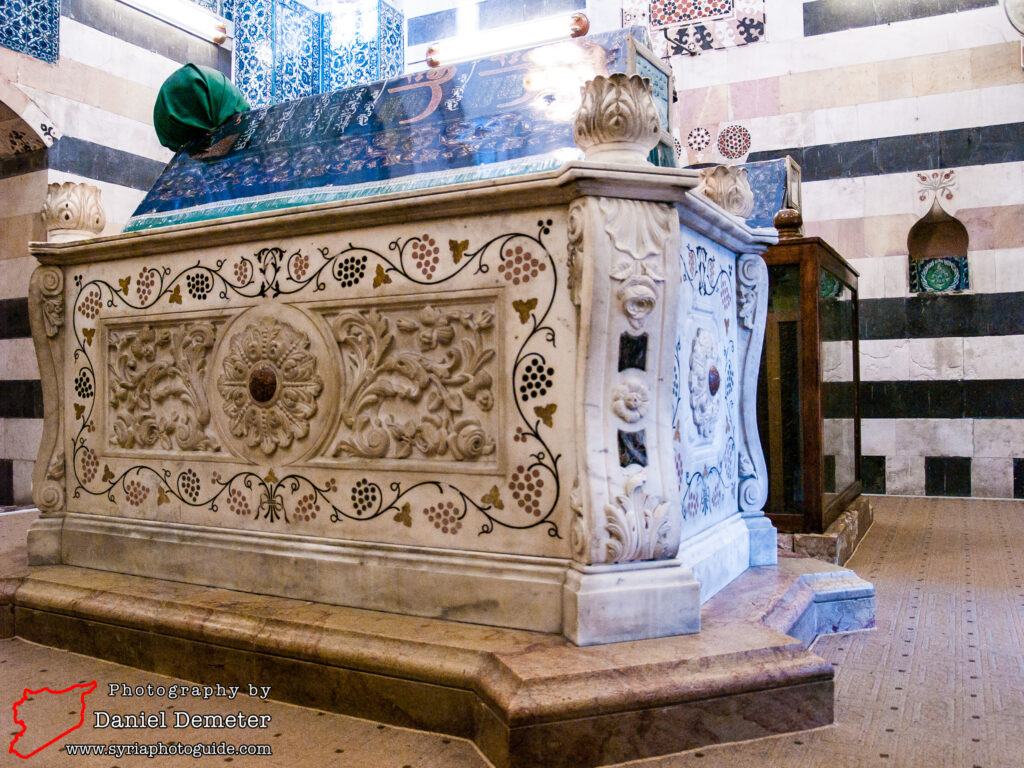
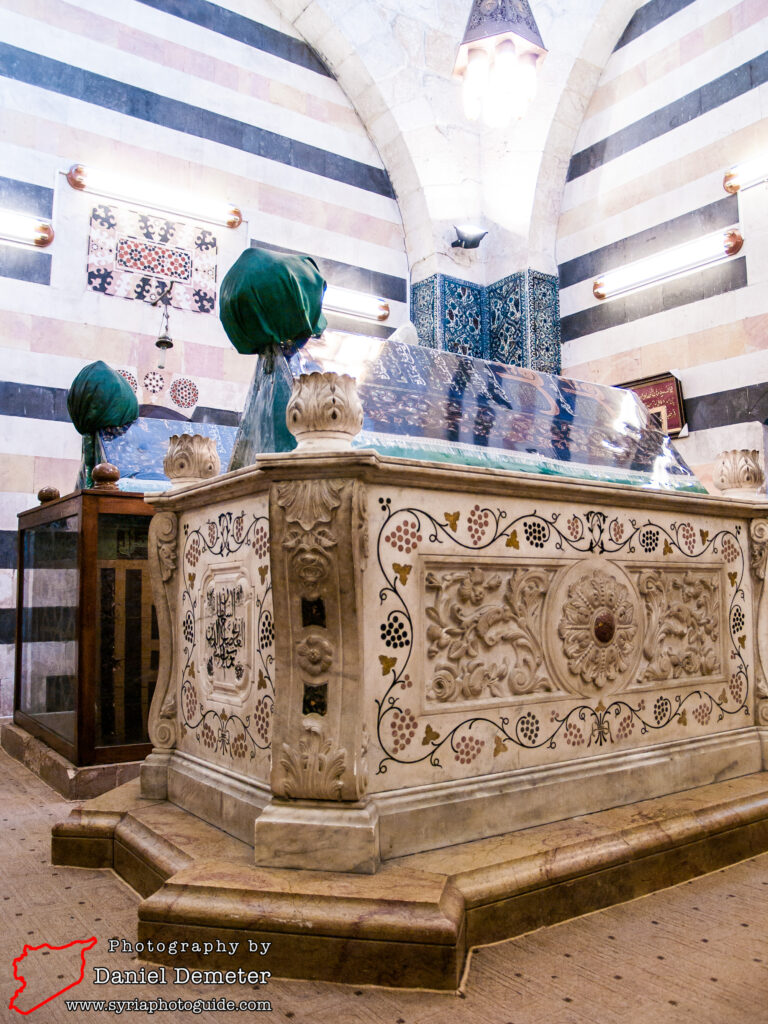
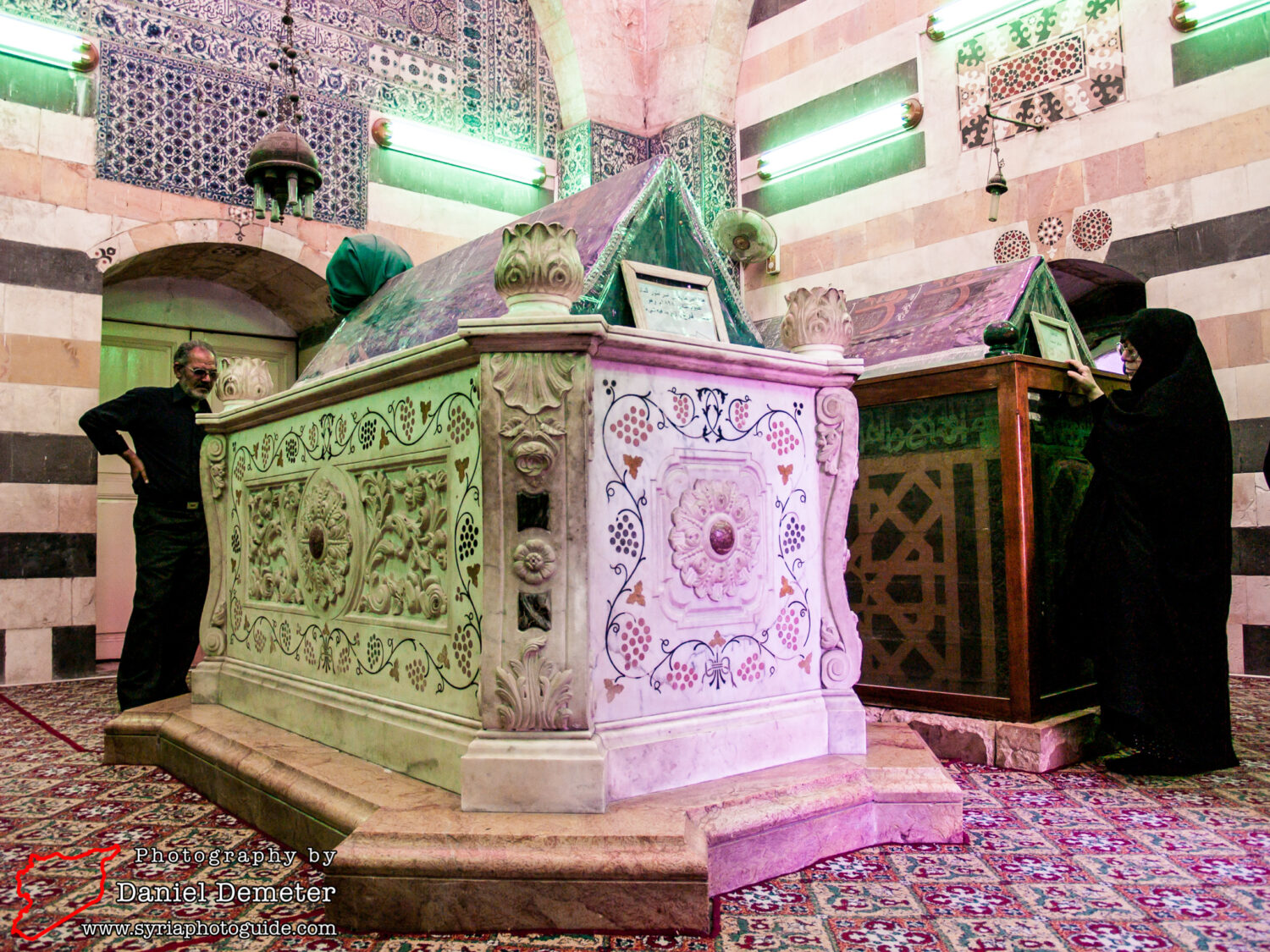
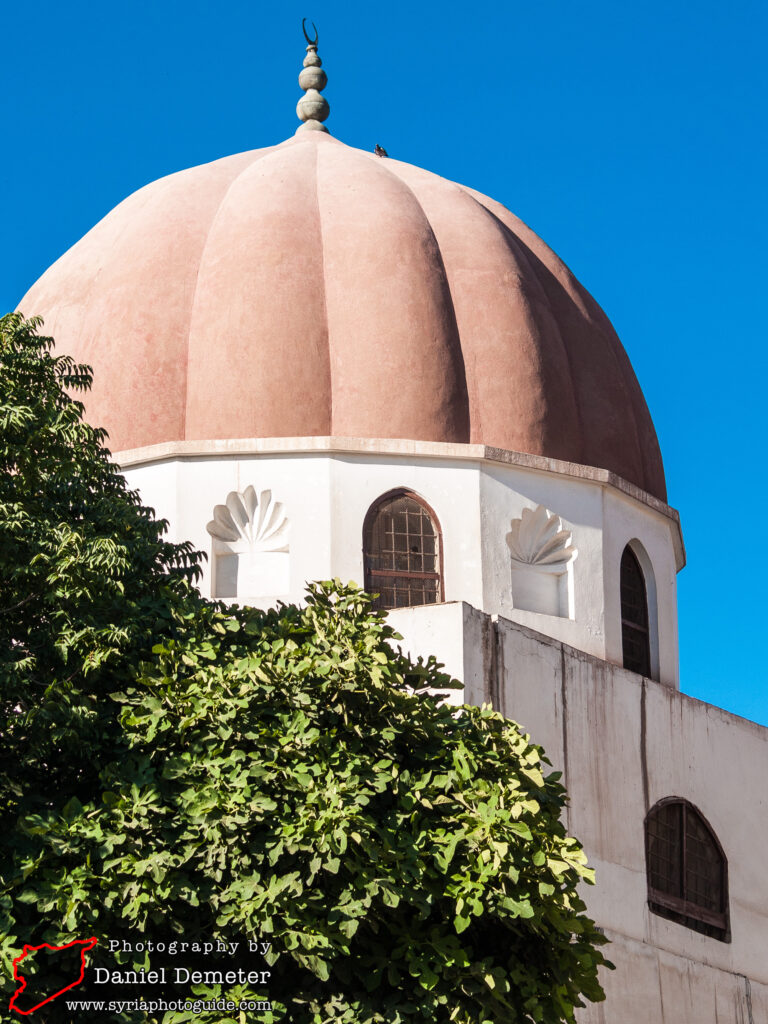
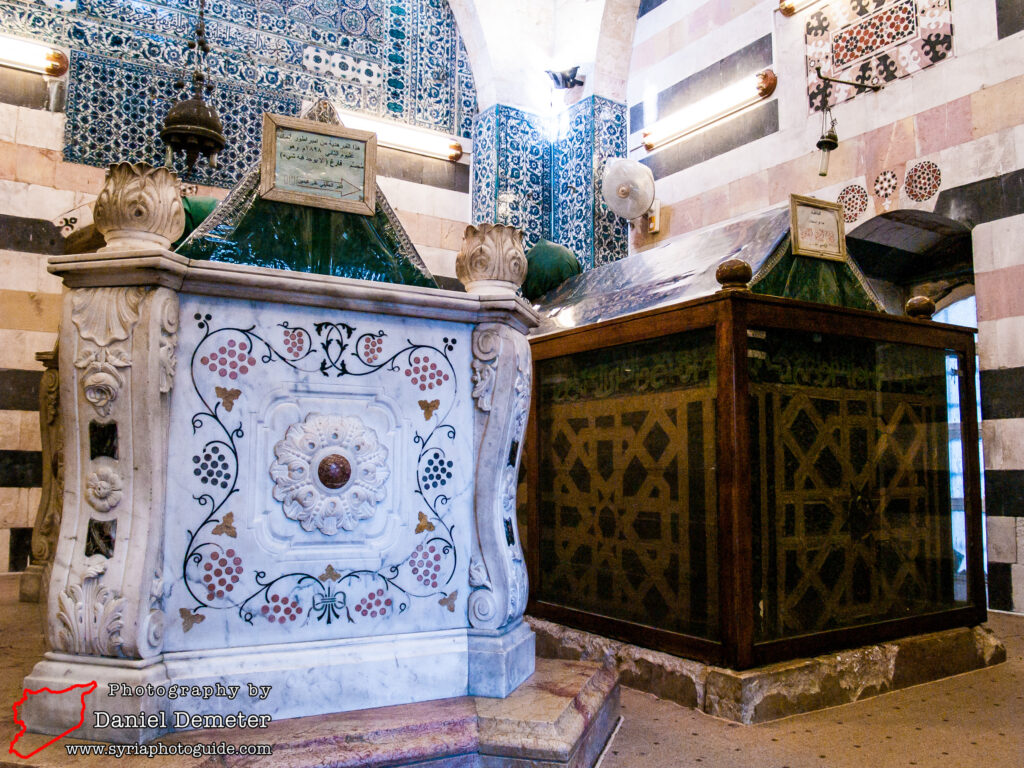
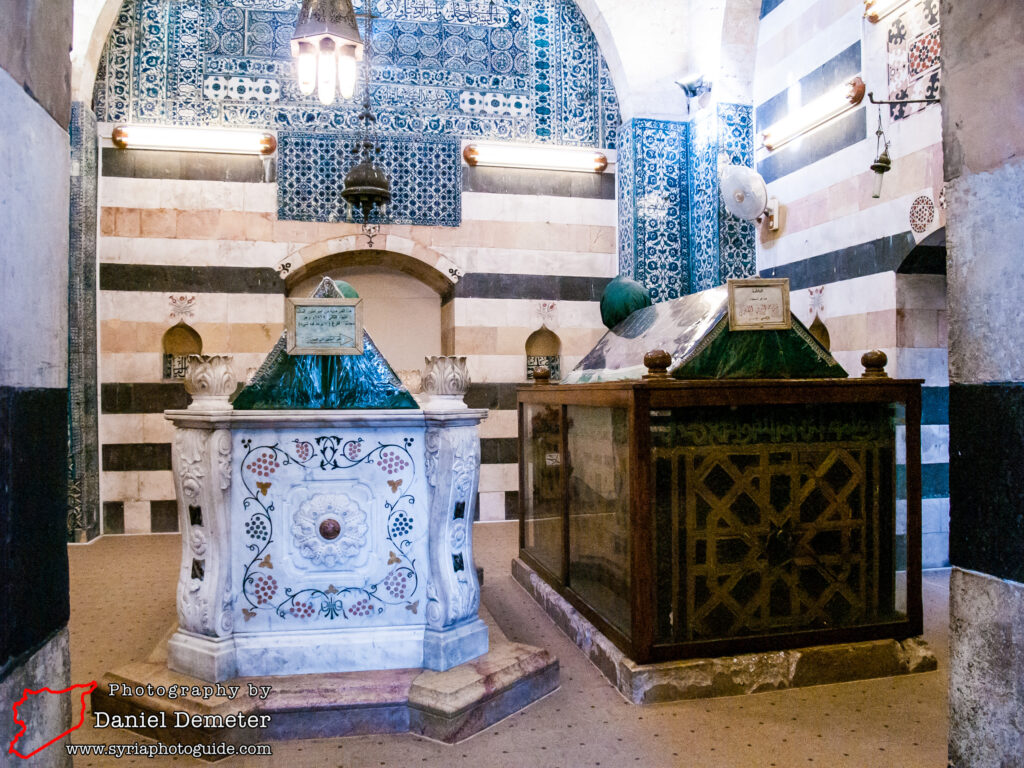
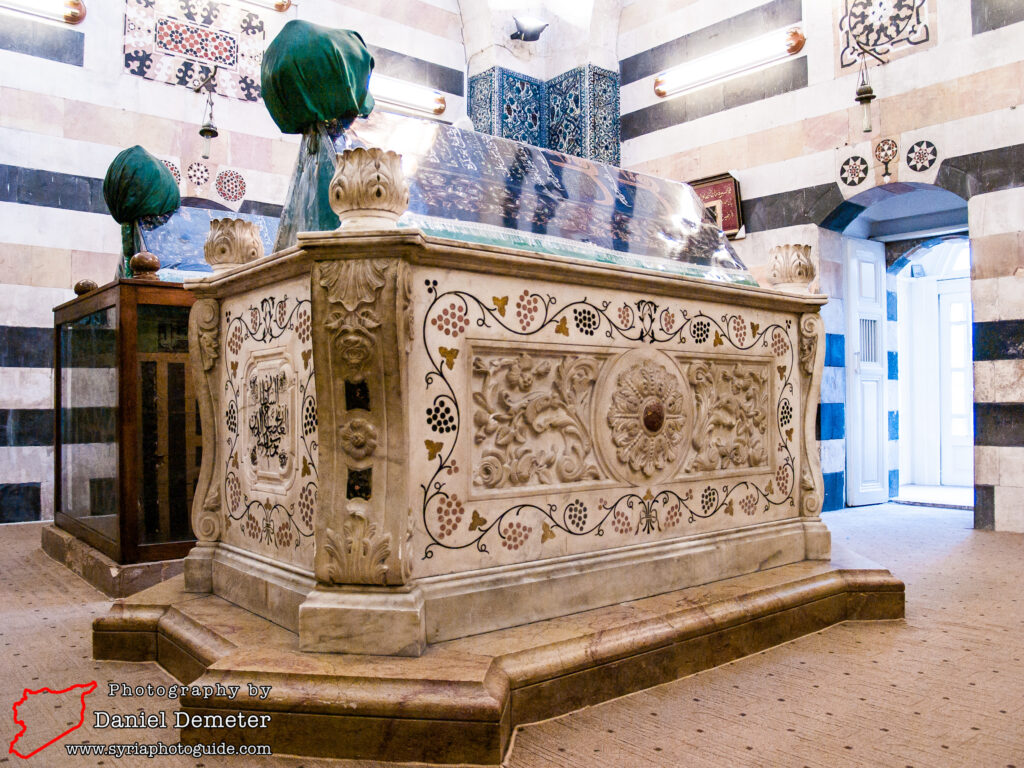
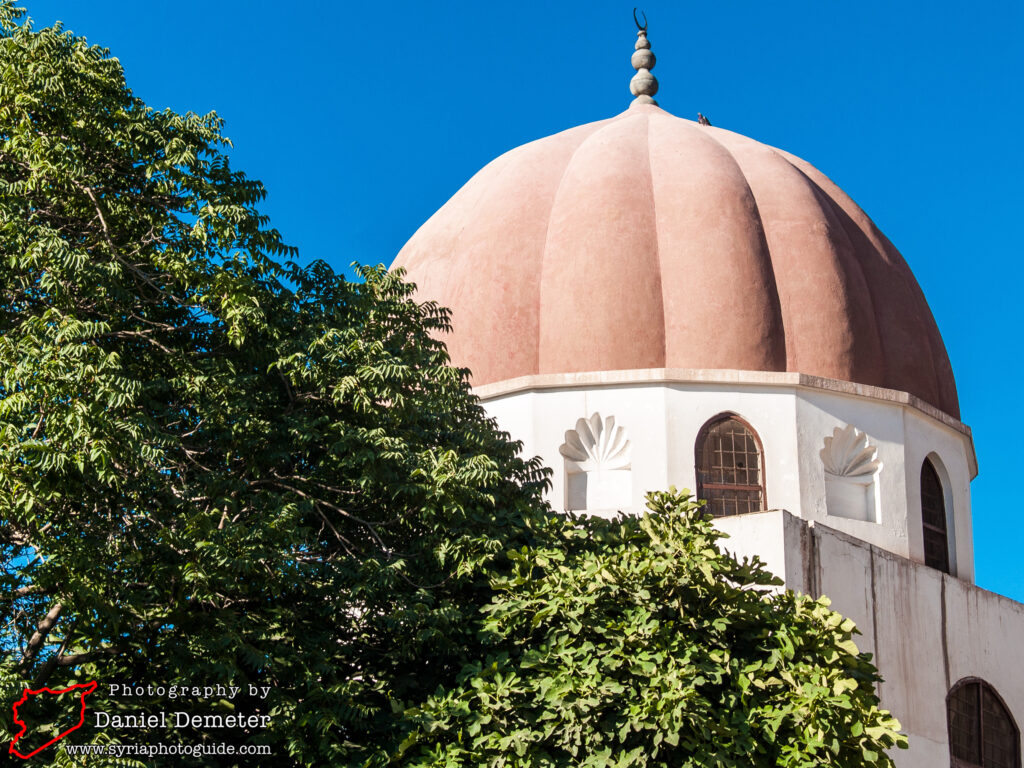
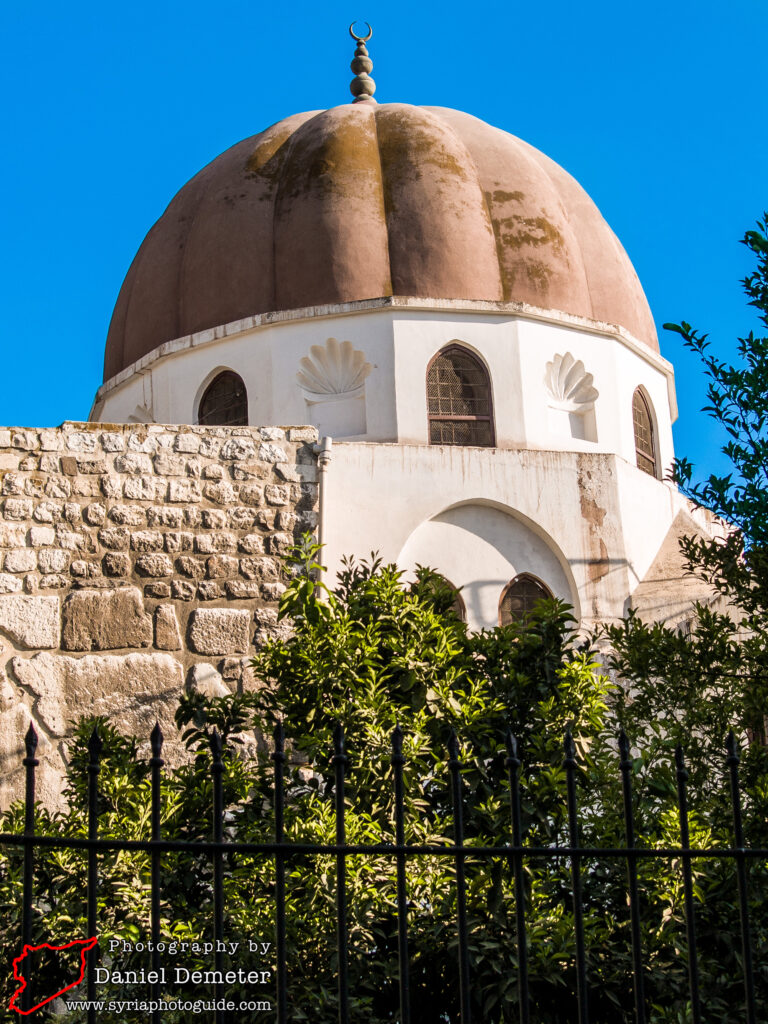
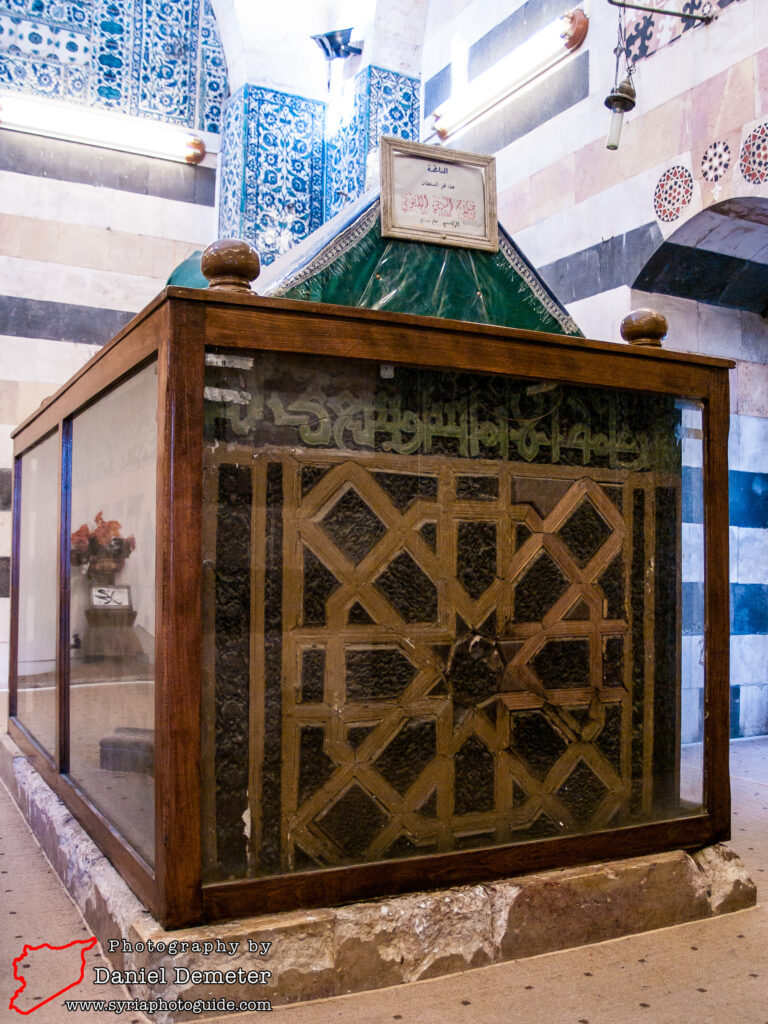
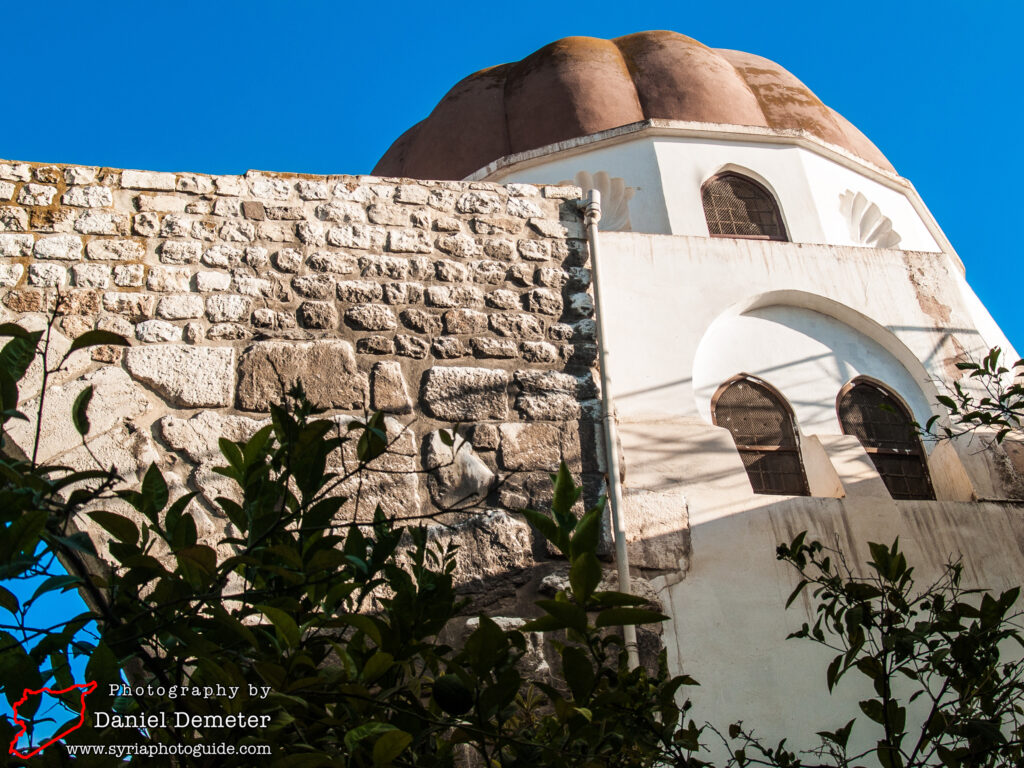

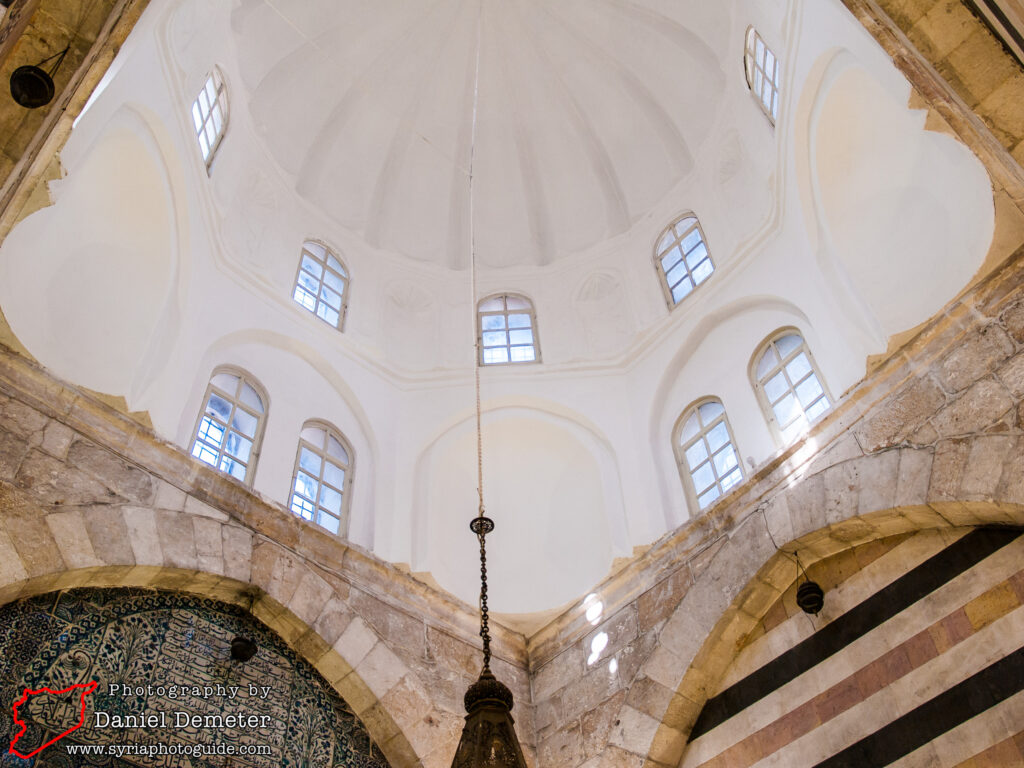
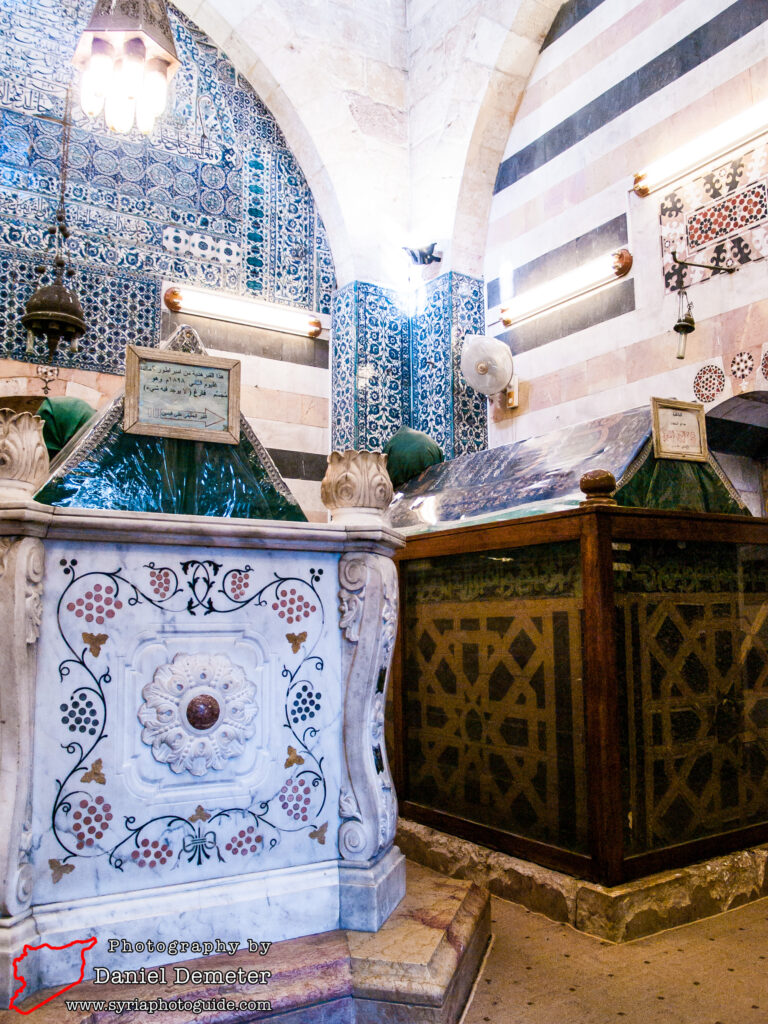
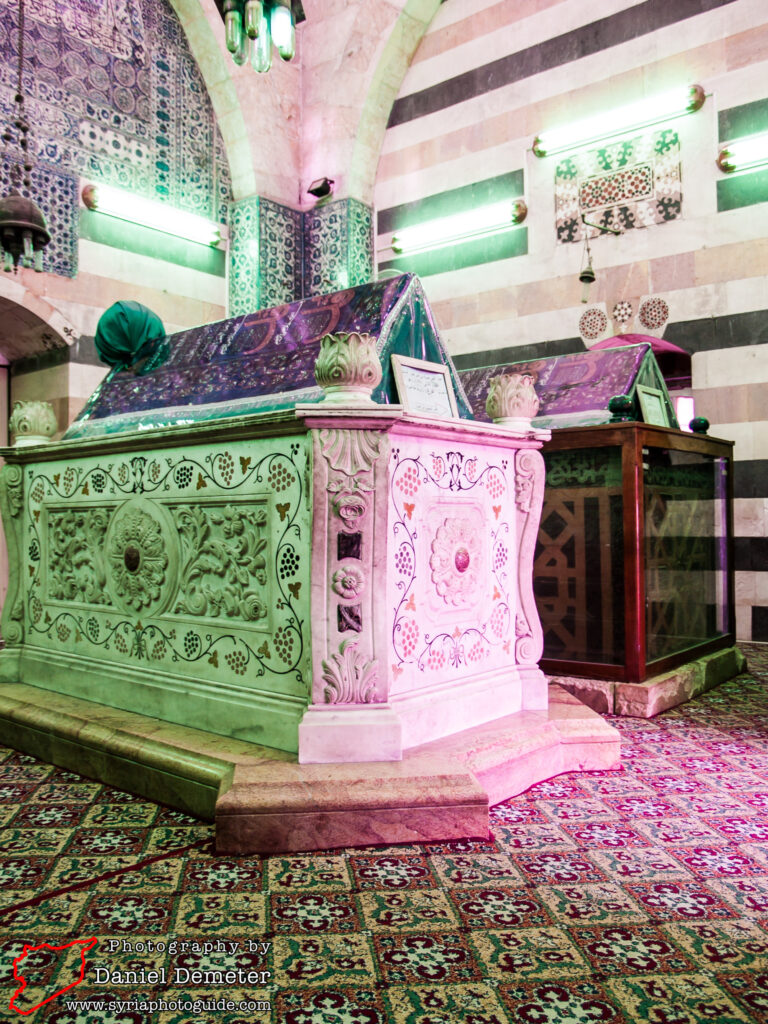
Getting There: The Tomb of Salah al-Din (قبر صلاح الدين) is located in the old city of Damascus (دمشق) less than ten meters away from the northwest corner of the Umayyad Mosque (الجامع الاموي).
Coordinates: 33°30’43.70″N / 36°18’21.40″E
Transliteration Variants: al-Madrasa al-Aziziye, al-Madrasa al-Aziziyah, al-Madrasa al-Aziziyah
Rating: 5 / 10
